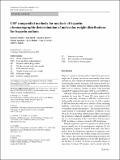USP compendial methods for analysis of heparin: chromatographic determination of molecular weight distributions for heparin sodium
Author(s)
Mulloy, Barbara; Heath, Alan; Jameison, Fabian; Al Hakim, Ali; Morris, Tina S.; Szajek, Anita Y.; Shriver, Zachary H; ... Show more Show less
Download216_2014_Article_7940.pdf (675.8Kb)
PUBLISHER_POLICY
Publisher Policy
Article is made available in accordance with the publisher's policy and may be subject to US copyright law. Please refer to the publisher's site for terms of use.
Terms of use
Metadata
Show full item recordAbstract
Heparin is a polysaccharide product isolated from glycosaminoglycans of porcine mucosa (or occasionally other tissues and species). It is a linear non-uniform polymer consisting of alternating glucosamine and uronic acid monosaccharide residues and is highly sulfated. Heparin sodium drug product (HP) used in medicine consists of chains with molecular weight (MW) ranging from under 5,000 to over 50,000. Although HP has been used as an injectable antithrombotic medicine for more than 70 years, many aspects of its structure and purity, including its MW, have not been specified by public standards until recent years. In 2008, a number of HP lots associated with severe adverse effects, including fatalities, were found to have been contaminated with oversulfated chondroitin sulfate. This incident led to thorough revision of compendial standards worldwide. In the USA, the Food and Drug Administration (FDA) encouraged the inclusion of enhanced standards for purity and identity in the relevant monographs of the United States Pharmacopeia (USP) including acceptance criteria for MW distribution.
Date issued
2014-06Department
Massachusetts Institute of Technology. Department of Biological EngineeringJournal
Analytical and Bioanalytical Chemistry
Publisher
Springer Berlin Heidelberg
Citation
Mulloy, Barbara et al. “USP Compendial Methods for Analysis of Heparin: Chromatographic Determination of Molecular Weight Distributions for Heparin Sodium.” Analytical and Bioanalytical Chemistry 406.20 (2014): 4815–4823.
Version: Author's final manuscript
ISSN
1618-2642
1618-2650